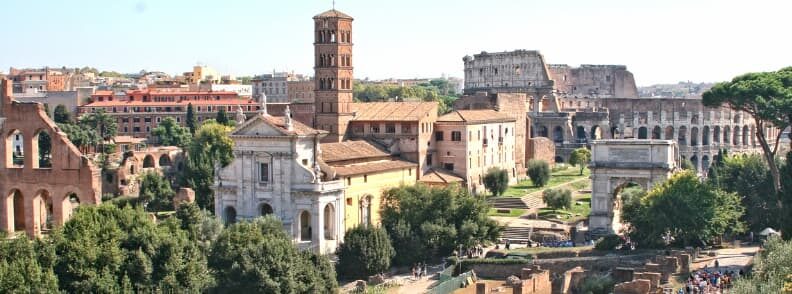This year, both Mathieu and I turn 30. For his birthday, in April, I wanted to do something special and go travel somewhere together. He had never been to Italy, which I love, so, in the end, I decided on a Rome holiday.
This involved a lot of planning: there’s so much to see in Rome and there were so many places I wanted to show him! However, I allowed plenty of time to just enjoy the moment, stop for a drink, or do whatever else we felt like doing in The Eternal City.
By the way, do you know why is Rome called The Eternal City or La Citta Eterna, in Italian? Apparently, the poet Tibullus gave Rome this name in the 1st century. The idea of an everlasting city was suggested by the strength and power of the Roman Empire in Antiquity. Rome cannot be taken down, Rome will survive everything history has to throw at her. Rome is eternal!
Rome Holiday Itinerary Day 1
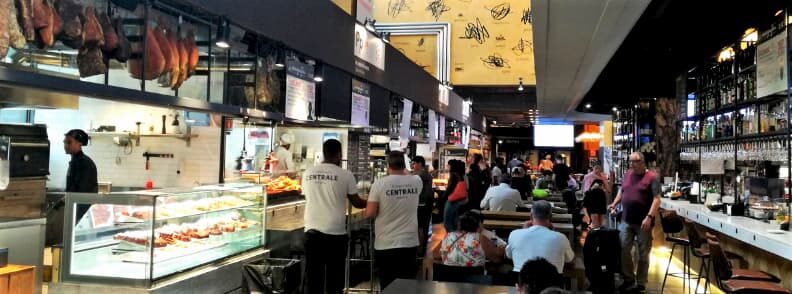
Lunch at Mercato Centrale
On the first day of the Rome holiday, we got very lucky. We landed on time, managed to catch a bus that was leaving earlier than planned, and dropped us off at Mercato Centrale, right by the entrance.
Of course, we went in and faced some difficulties in what to choose to try from the multitude of options. We settled on some salty pastry rolls, a piece of salty pie, and pizza. Perfect start to our Rome holiday, no?
Then, the owner of the place we were staying told us we can check in earlier. All of this got us a head start of about 2 hours for our Rome holiday!
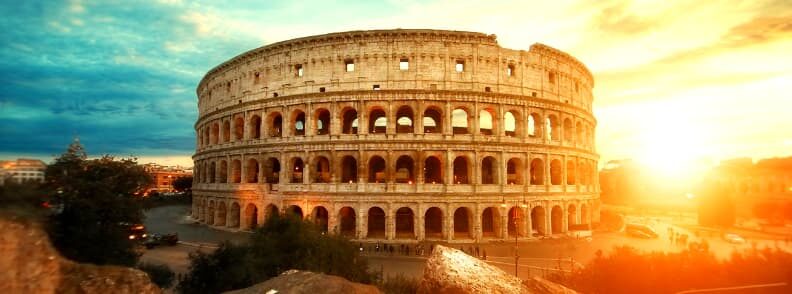
The Colosseum
This Rome holiday was my second, the first one taking place 10 years ago this year. It was amazing to discover places I had visited before in Rome in the same great condition or even restored. The number of visitors, however, seemed a lot higher this time.
When we arrived at the Colosseum, it was very crowded and there were people offering to help us find our way, although we could never tell if they wanted to sell us something or point us in the right direction. We booked online tickets to the Colosseum and it was a great choice because the line was a lot smaller. (Yes, normally you skip the line, but there is a line with people who are skipping the line. )
However, the directions were really bad, not just here, but also at the Roman Forum later. Their signs aren’t consistent, and while in some places online tickets are separate from Roma Pass, in others it just says Roma Pass, and you are supposed to be aware that that’s where you’re supposed to go. Just keep this in mind for your own Rome holiday.
But anyway, once inside, the Colosseum was as impressive as ever. (Well, not ever, I’m sure it was more impressive in its own time than during our Rome holiday.)
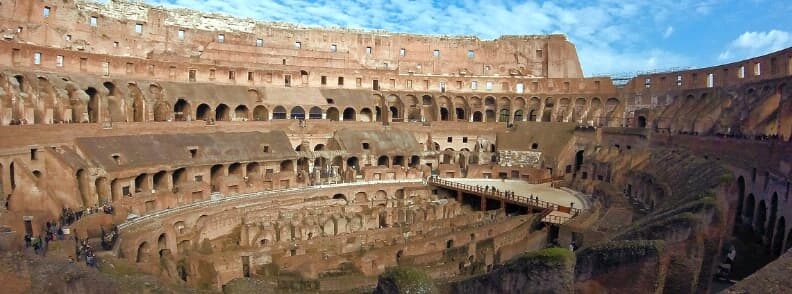
Colosseum history
The Colosseum, also known as the Flavian Amphitheatre, is the most important edifice of Rome, not only for its considerable size but also for its solid and admirable structure. Its construction began in 79 AD and the Colosseum was inaugurated in 80 AD by Titus with games that lasted for 100 days. During this celebration, around 5,000 (!) animals were killed.
After gladiator battles were forbidden in the year 438, the amphitheater was used for hunting wild beasts until 523. Its subterranean was built at the end of the first century to accommodate naval battles, as well.
The Colosseum was initially a place to entertain the people and it is thought that it could fit between 40,000 to 73,000 spectators (almost as many as the largest current stadium in the world). In the Middle Ages, the Colosseum was transformed into a fortress, then it became a stone quarry for the building of the Renaissance palaces. Around 1750, Benedict XIV transformed it into Via Crucis.
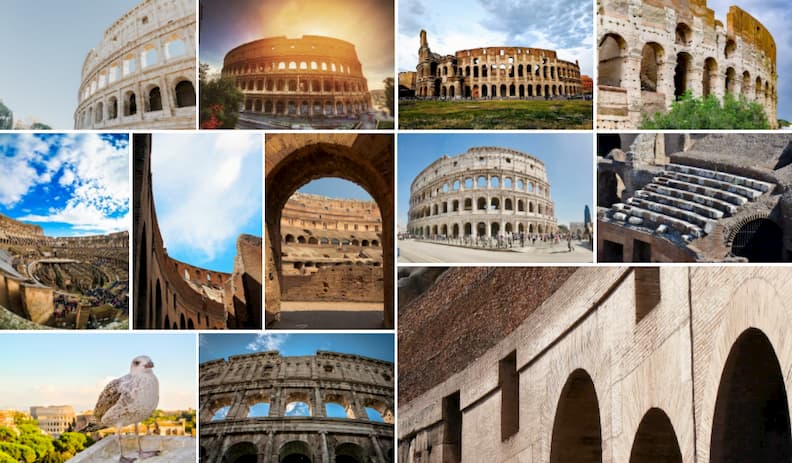
After all that, the Colosseum went through several stages of restoration to get to how tourists see it now when they go on a Rome holiday.
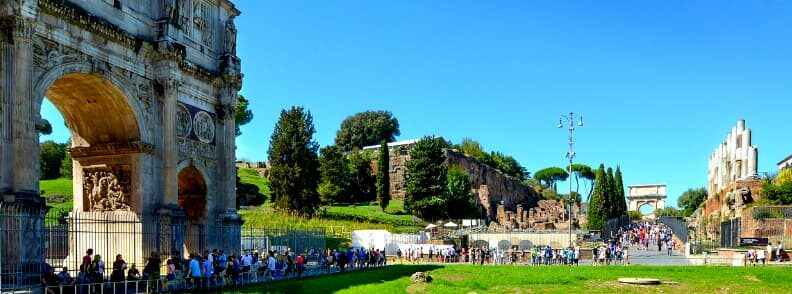
Arch of Constantine
Once we got out of the Colosseum, we headed to the Arch of Constantine, which is the most important and best-preserved of the Roman arches.
The marble arch is 7.4 meters (24.3 feet) deep, 25.7 meters (84.2 feet) broad, and 21 meters (69 feet) tall. It actually has three arches, the biggest of which is the central one. Scenes from Constantine’s life and representations of gods and goddesses from Roman mythology are among the relief sculptures and inscriptions that cover the arch.
It is known as the Arch of Constantine because, until recently, it was thought to have been built as a monument to Maxentius’ defeat by Constantine I at the Battle of Milvian Bridge in 312 AD. Restauration works from the 1980s proved that it was actually raised during the times of Hadrian, with sections from the times of Trajan and Aurelian.
By the time we finished visiting the Colosseum, it got too crowded to truly appreciate the monument from up close, so we moved on to explore the Roman Forum. We actually covered a lot of ground on the first day of our Rome holiday, so bear with me!
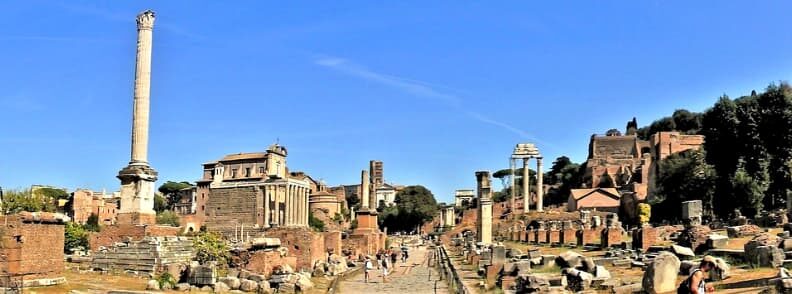
The Roman Forum
Near the Colosseum in ancient Rome was the public plaza known as the Roman Forum. Numerous significant public structures and monuments, like the Senate House, the Temple of Saturn, and the Arch of Septimius Severus, were located there.
The Roman Forum served as the city’s political, economic, and social hub. It was the center of the Roman Republic and subsequently the Roman Empire. Here, significant occasions including public discourse, elections, and trials took place. Many of the historic buildings and structures that previously existed in the Roman Forum are still visible to tourists today, making it a popular tourist destination in Rome.
We entered the Roman Forum by walking on Via Sacra, which used to be the main street in Ancient Rome. Via Sacra takes you from the Colosseum to the top of Capitoline Hill. It passes through some of the most important religious sites of the Roman Forum.
It’s a bit difficult to get around, but you don’t truly need a guide on your Rome holiday. You have detailed information next to each site, and you can also look for free apps to help you get your bearings.
Below is a list of what you can discover in the Roman Forum, and I recommend this order:
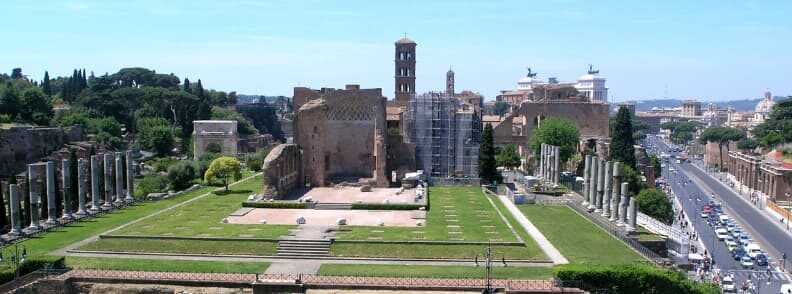
Temple of Venus and Rome
Near the Colosseum and the Roman Forum stood a huge temple called the Temple of Venus and Rome. It was dedicated to Rome, the embodiment of the city of Rome, and to Venus, the Roman goddess of love and beauty.
Between 121 and 135 AD, during the Roman Empire, Hadrian the Great erected the temple dedicated to the goddesses Venus Felix and Roma Aeterna. It was one of Rome’s biggest and most lavish temples, and it was embellished with many different sculptures and reliefs. Although the temple was demolished in the fifth century AD, its remnants are still visible in Rome today.
Located on Velian Hill, the ruins of this Roman temple offer a wonderful view over the Colosseum.
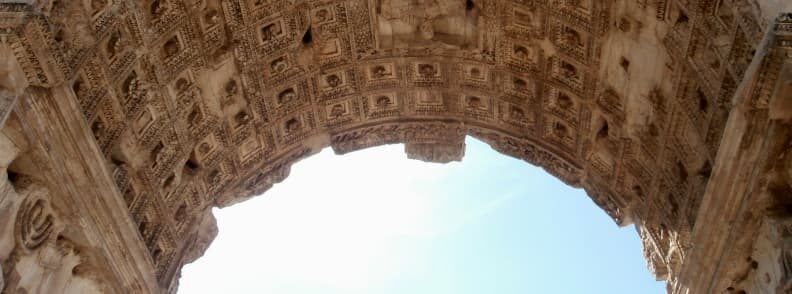
Arch of Titus (Arco di Tito)
Walking up the Via Sacra, you will come across a triumphal arch known as the Arch of Titus on the Southeastern side of the Roman Forum.
The Arch of Titus was raised to commemorate Roman Emperor Titus’s triumph over the Jews during the Siege of Jerusalem in 70 AD. The marble arch is 4.75 meters (15.6 feet) deep, 13.5 meters (44.3 feet) broad, and 15.4 meters (50.5 feet) tall.
Arco di Tito Roman Forum has a single archway and is embellished with many relief sculptures and inscriptions, including representations of Titus and his army and events from the Siege of Jerusalem.
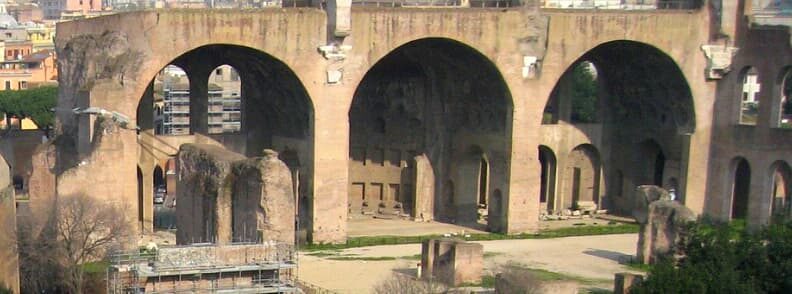
Basilica of Constantine and Maxentius
The Basilica is also known as Basilica Nova or the Basilica of Maxentius, and it used to be the largest building in the Roman Forum.
The construction of this magnificent building, one of the most imposing in Rome, was started by Maxentius in 206 and finalized by Constantine in 312. The initial entrance used to be on the East was changed to the Southern side. This might have happened in order to change the orientation of the building and thus the perception of this huge space.
One of ancient Rome’s biggest and most elaborate structures, Basilica Nova was used for a wide range of public events, including courtroom sessions and religious celebrations. Although the Basilica of Maxentius was demolished in the fifth century AD, its remnants are still visible in Rome today.
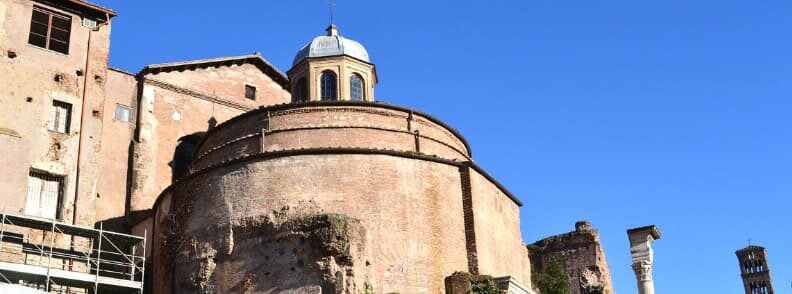
Temple of Romulus (Tempio dei Divo Romolo)
The name of the temple might trick you into thinking it’s dedicated to the legendary Romulus, when in fact it refers to a son of Maxentius — Valerius Romulus. And it seems it’s not even an actual temple, but it’s believed to have been the office of the urban praetor. Still, an interesting sight on a Rome holiday, don’t you think?
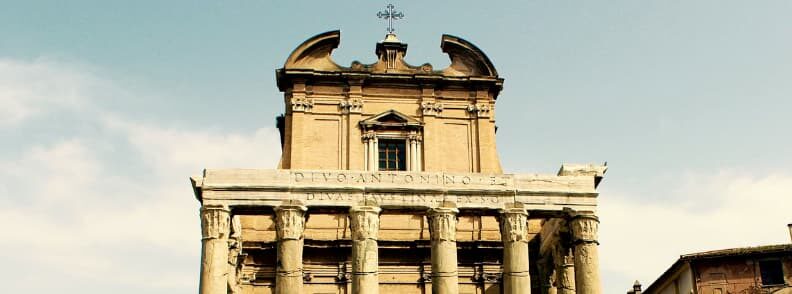
Temple of Antoninus and Faustina
This temple is in excellent condition, even to this day. It was erected in 141 AD when Faustina, the wife of Emperor Antoninus, died and was deified. After the Emperor’s death, the temple was equally dedicated to him, as well.
The marble temple was built in the Corinthian style. There is a large cella (inner chamber) in the Temple of Antoninus and Faustina interior, and a colonnade of Corinthian columns surrounds it.
The Temple of Antoninus and Faustina was transformed into a church in the seventh century AD. and is currently known as the Chiesa di Sant’Anna dei Palafrenieri.
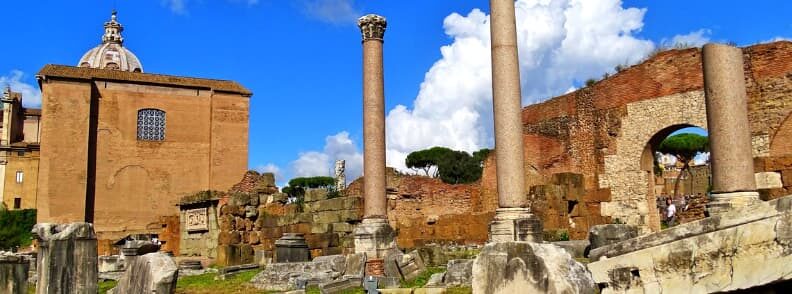
Basilica Emilia (Basilica Aemilia)
The Basilica was founded in 179 BC, and it was restored several times by Augustus. It used to be a building where people could go about their business in the Forum, protected from the weather elements.
Basilica Emilia was once 100 meters long and around 30 meters wide. It had two rows of arches, standing on top of one another, which, on the ground floor, represented the entrances of various shops. The interior (90 meters long and around 29 meters wide) was accessible through three separate entrances.
Unfortunately, today we can only see the plan and some rebuilt elements of Basilica Emilia, the only remaining Republican basilica out of four.
The Senate House (Curia Julia)
The large building, mostly intact, is Curia Julia, which used to house the meetings of the Roman Senate. It’s one of Rome’s oldest and most significant governmental structures, and it is named for Julius Caesar, who started its construction. Emperor Augustus finished it. Later, it was redone by Diocletian, who converted it into the Basilica of Sant’Adriano al Foro in the 7th century.
The rectangular Curia Julia was constructed of marble and cement. It had a sizable, high-ceilinged center hall that was encircled by smaller rooms and hallways. The wooden ceiling was 21 meters high, 27 meters long, and 18 meters wide. Part of the marble floor is the original one.
It’s really something else, so make sure you have a look at it during your Rome holiday.
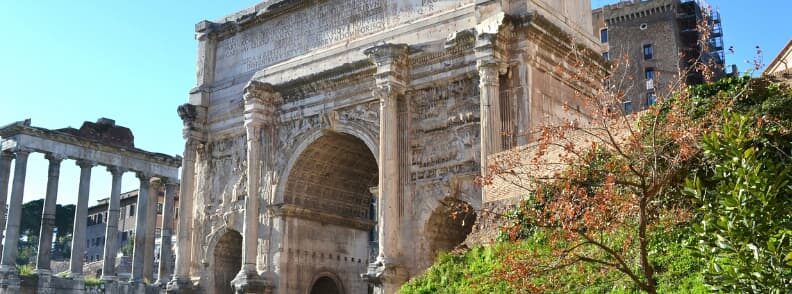
Arch of Septimius Severus (Arco di Settimio Severo)
The Arch of Septimius Severus is a triumphal marble arch located on the northwestern side of the Roman Forum. It is 25.9 meters (85.0 feet) in width, 7.4 meters (24.3 feet) in depth, and 21.4 meters (70.2 feet) tall.
It contains three openings and is embellished with several relief sculptures and inscriptions, including representations of Septimius Severus and his sons – Caracalla and Geta, victories, deities, Roman soldiers, and their prisoners, together with other scenes from the campaigns against the Parthian Empire (ancient Iran and Iraq).
The Rostra (Rostra Augusta)
Romans would congregate in the busy marketplace and public square known as the Roman Forum to transact business, mingle and hear political leaders make speeches.
The Rostra, also called the Rostra Augusta, was a podium in the Roman Forum where prominent people such as politicians would address the gathering throng. It was given its name from the carved rostra, or ship prows, that embellished its front when it was first constructed in the fourth century BC. That is why it is also a significant representation of Rome’s naval might.
Rostra Augusta served a number of functions, including public speeches, elections, and court proceedings. Numerous significant historical events took place here as well, like Julius Caesar’s funeral oration.
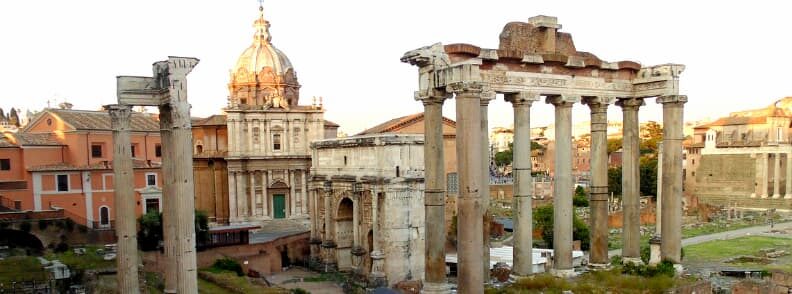
Temple of Vespasian and Titus
This Roman temple was built in 81 AD by emperor Domitian, in recognition of Vespasian and Titus’ triumph in the Jewish War and their assistance in the Colosseum’s construction. The marble temple was ornamented with reliefs showing episodes from the conflict and other historical events.
The Temple of Vespasian and Titus had sculptures of Vespasian, Titus, and other members of the imperial family. It was a crucial representation of the dynasty’s might and prosperity, and a significant location in Rome for a long time.
Only three columns remain, part of a hexagonal pronaos. You can see it in the image above, on the right side.
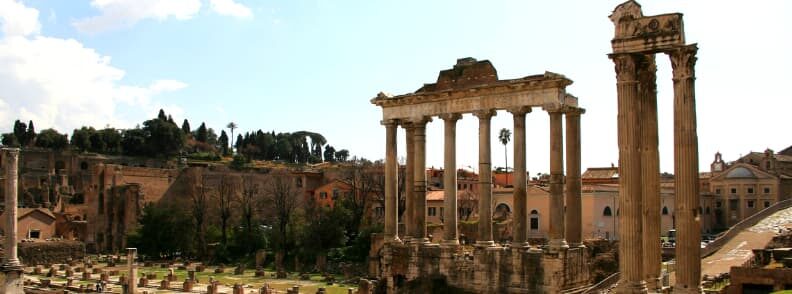
Temple of Saturn (Tempio di Saturno or Aedes Saturni)
The deity Saturn was honored at the Rome temple known as the Temple of Saturn. One of Rome’s oldest and most significant temples, it was built in the early years of the Roman Republic, and it had a number of functions, including housing the national treasury and hosting the annual Saturnalia festival. The majestic marble temple was ornamented with reliefs showing events from Roman mythology. A statue of Saturn, the god of agriculture and abundance, was also within.
For many years, the Temple of Saturn was a significant landmark in the city and served as a representation of Rome’s strength and stability. Over time, the building was redone several times, the last time after the fire of 283 AD.
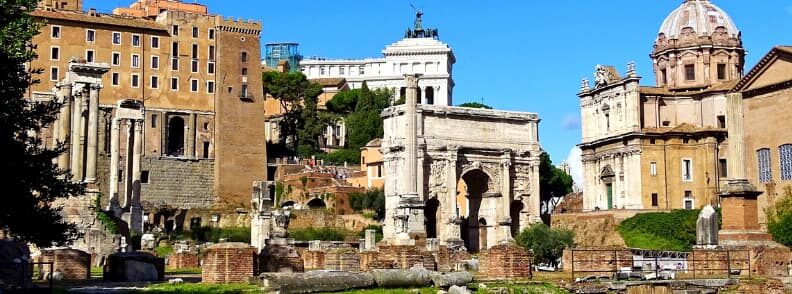
The Column of Phocas (Colonna di Foca)
The Column of Phocas is the last monument that was built in the Roman Forum. It was dedicated to Emperor Phocas on 1 August 608 AD
The marble column was embellished with inscriptions honoring Phocas’ actions and reliefs showing scenes from his reign. A statue of Phocas himself, clutching a cross in one hand and a globe in the other, topped the column.
A significant representation of Byzantine dominance in Rome, the Column of Phocas stood for many years after the collapse of the Byzantine Empire. Ultimately, it was destroyed in the 16th century when the Holy Roman Empire sacked Rome.
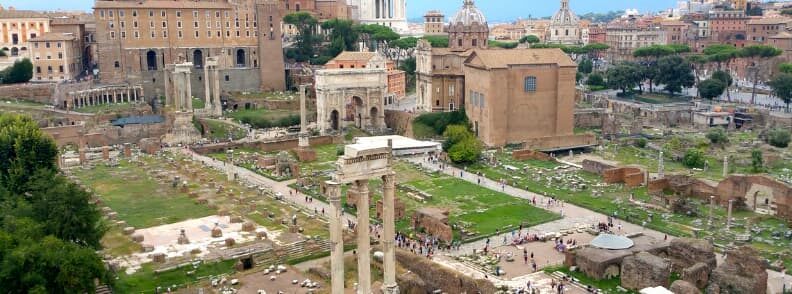
Basilica Julia (Basilica Giulia)
Basilica Julia, 101 meters long and 49 meters wide, used to be the largest and most luxurious building in the Roman Forum. It was built by Caesar in the first century BC, and he gave it his own name. Later, it was redone by Augustus, and restored by Domitian after the fire of 283 AD.
The basilica served as a courthouse, a location for official activity, a market, and a venue for gatherings. It was constructed of marble, and reliefs illustrating episodes from Roman mythology were used to embellish it. The grand central hall (82 meters long and 18 meters wide) was surrounded by a double row of pillars.
For many years, the Basilica Julia was a significant landmark in Rome and served as a representation of Roman authority and culture. The Roman Forum still has some of its remnants, despite the fact that it was ultimately destroyed in the fifth century AD during the Gothic War.
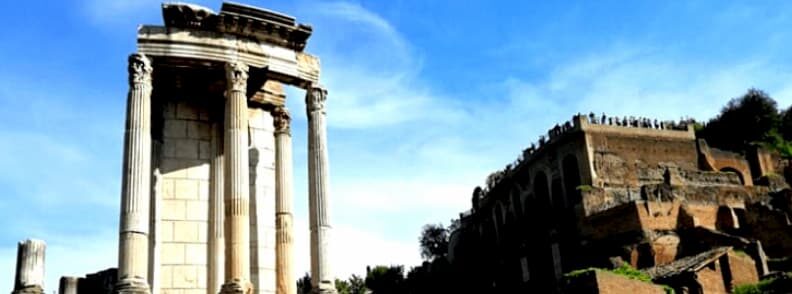
Temple of Vesta (Tempio di Vesta)
The Temple of Vesta was dedicated to the goddess Vesta, associated with the hearth, the home, and the family. The Vestal Virgins, a group of virgin priestesses devoted to the goddess Vesta, cared for the sacred fire – the symbol of the state – inside this temple.
One of Rome’s oldest and most revered temples, the structure imitates in marble the simple structure of the cabin it replaced during the time of Septimius Severus. It was built in the fourth century BC and ornamented with reliefs showing episodes from Roman mythology.
I find it among the most elegant parts of the Roman Forum, so I urge you to make a stop for a photo here on your Rome holiday.
House of the Vestals (Atrium Vestae)
The Vestal Virgins, a group of virgin priestesses devoted to the goddess Vesta, resided at the House of the Vestals in Rome where they cared for the holy fire in the Vesta Temple. Also known as Atrium Vestae, the fourth-century house was made of granite and decorated with episodes from Roman mythology.
Roman society held the Vestal Virgins in high regard and accorded them unique rights and honors. They were also expected to maintain their virginity during the 30 years of their service.
The Vestal Virgins’ home was large and beautiful but shut-in.
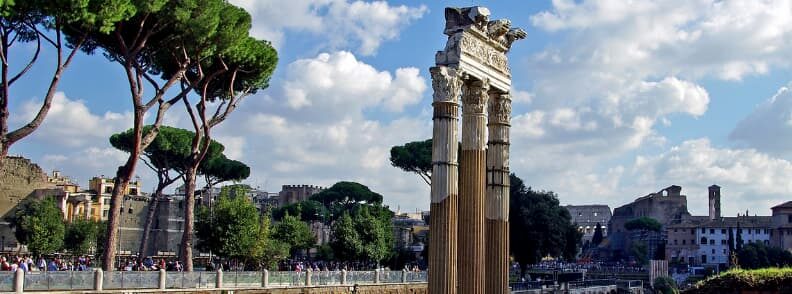
Temple of Julius Caesar (Tempio di Divo Giulio)
Also known as the Temple of the Comet Star, this is another nice stop for your Rome holiday.
Wondering why the Temple of Julius Caesar is called the Temple of the Comet Star?
Well, in 44 BC the most famous comet of antiquity could be seen in the sky for 7 days. Named Comet Caesar or the Great Comet of 44 BC, it was considered by the Romans a sign to deify the recently assassinated Julius Caesar. Thus, Caesar became the first Roman to be deified after his death.
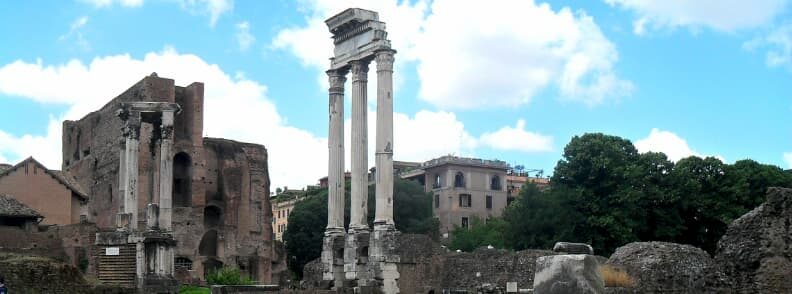
Temple of Castor and Pollux (Temple of Dioscuri)
Close to the end of the Basilica Julia, you can see the remains of the Temple of Castor and Pollux while visiting the Roman Forum on your Rome holiday. Three beautiful white columns still stand on its gigantic podium.
The twin brothers Castor and Pollux, significant figures in Roman mythology, were honored in this Roman Temple. Initially dedicated to the twin sons of Jupiter in 484 BC, the temple was restored in 117 BC (this is when the podium was built) and in the year 6 AD (this is when the columns were erected).
Made of granite, it was embellished with reliefs illustrating episodes from Roman mythology. Inside, there was a statue of the twins, who were regarded as the patrons of horsemanship and frequently implored by the Roman soldiers for protection and victory in war.
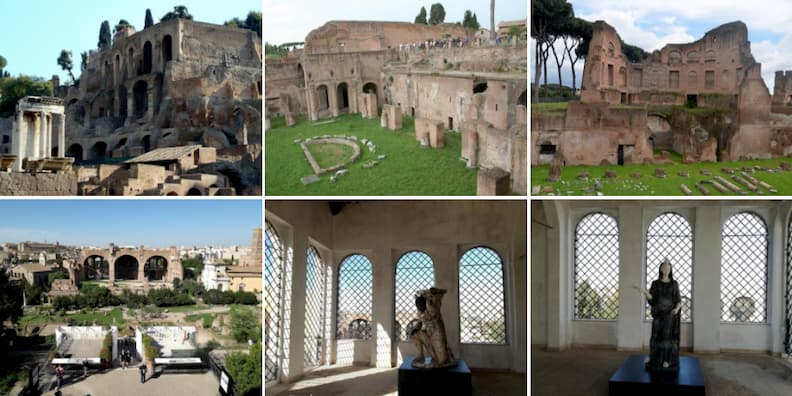
The Palatine Hill
At 40 meters above the Roman Forum, stands the majestic Palatine Hill, one of the seven hills of Rome. According to Roman mythology, Romulus and Remus are said to have founded Rome on the hill.
The Palace of the Flavian Emperors, the Circus Maximus, and the Temple of Apollo are just a few of the significant ancient Roman structures and remains that can be seen in the city’s heart. Many of Rome’s richest and most prominent inhabitants lived on Palatine Hill, which served as a significant hub of Roman society. It’s a vast area to explore, with various surprises behind the gorgeous vegetation (e.g. a bathtub hidden between some bushes).
What impressed me the most was the Farnese Aviaries. The Farnese family’s main house, the Gardens of the Farnese Palace, was where the aviaries were situated. A variety of exotic birds, including parrots, peacocks, and other uncommon species, were housed in the 16th-century aviaries.
The aviaries were a well-liked tourist destination in Rome and were regarded as one of the city’s marvels. The Farnese Palace’s remnants, including the aviaries, were ultimately demolished in the 18th century, although they are still visible in Rome today.
We actually got lucky we got to see these, as they were still under restoration until April 2018. If I think about it, we were lucky with a lot of things on our Rome holiday. Stay close and you’ll see what I mean!
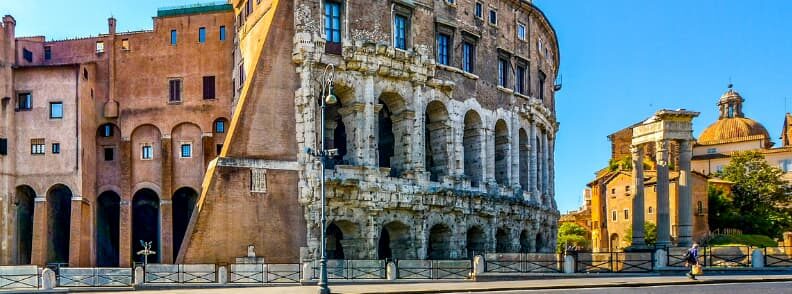
Teatro Marcello
We left the Palatine and the Roman Forum through an exit on Via dei Fori Imperiali. We walked towards Campidoglio, went down the Cordonata Capitolina, and wandered on the streets a bit, ending up at Teatro Marcello.
Teatro Marcello, commonly referred to as the Theater of Marcellus, was erected in the first century BC on the banks of the Tiber. It was given the name Marcus Marcellus in honor of the Roman commander and statesman who was Julius Caesar’s nephew.
One of ancient Rome’s biggest and most spectacular open-air theaters, it resembled a miniature Colosseum. It was made of marble decorated with reliefs with episodes from Roman mythology. The theater was used for a variety of events, such as plays, concerts, and speeches in front of an audience. It was a significant location in Rome and was used for a long time before being abandoned and falling into decay.
But this is Rome, where history blends with everyday life, and on top of the theatre you now have private apartments, and, in this setting, during Summer, there are still concerts. It’s amazing, so don’t skip this amazing area on your Rome holiday!
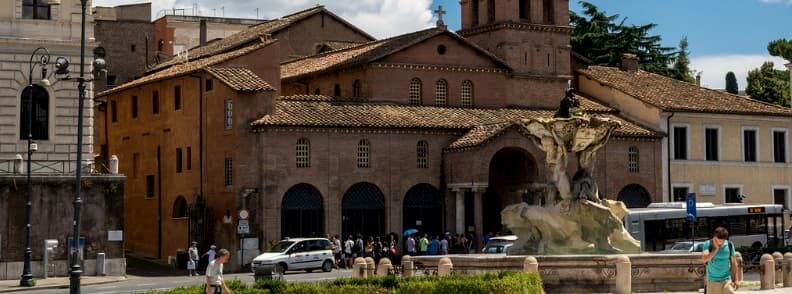
Bocca della Verita (Santa Maria in Cosmedin)
Yes, we walked a lot and even saw the Tiber a bit, but quickly got farther away from its bank because Mathieu was terribly allergic to the trees growing there. So we ended up right next to Bocca Della Verita and Santa Maria in Cosmedin.
The Mouth of Truth or Bocca della Verità is a well-known marble sculpture in Rome of a human face with an open mouth. Located in the portico of the Santa Maria in Cosmedin church, the sculpture was formerly a component of a fountain or a drain, from the first or second century AD.
People were said to place their hands in the sculpture’s mouth and pledge to speak the truth, using it as a lie detector. It was thought that the sculpture would bite off their hand if they told a lie.
Unfortunately, the church was closed, maybe because of the time, maybe because it was under restoration. I had planned to take Mathieu to see Bocca Della Verita on the last day of our Rome holiday if we still had some energy and time left.
I know there’s quite a big fuss about it, but I’m not really impressed. And I was happy to see Mathieu wasn’t either. I showed it to him through the fence. “Do you want to come back, stay in line, then put your hand in its mouth for a few seconds…?” He smiled, shrugged, and said no. He’s perfect!

Roseto Comunale
Passing by Circo Massimo (yet another so-called must-see which we didn’t find impressive on our Rome holiday), we headed out to Rome’s public rose garden, to rest a bit, because it was a long day and we needed a break. The garden was so beautiful, full of amazing, colorful, and diverse roses, but we only walked some more while I took some pictures and left, because Mathieu’s allergy was acting up and he looked in pain.
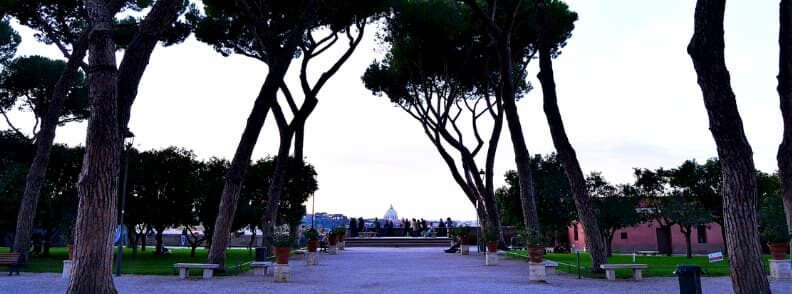
Giardino degli Aranci
A much nicer experience for Mathieu, as well, was our stop in Giardino degli Aranci, a beautiful orange garden on the Aventine Hill. The public park was established in the 19th century, and it got its name from the orange trees that can be seen here.
A favorite place for both visitors and locals, Giardino degli Aranci has expansive views over the city. Thanks to its lovely terrace, it is a charming spot for weddings and other events. It’s also one of the nicest spots to watch the sunset over Rome and the Vatican, but we were there an hour too early.
On the bright side, it wasn’t very crowded and we could finally sit on a bench to take in the amazing view. Of course, the longer we stayed, the more crowded it got. And no view was worth feeling like a sardine at the end of a hot, tiring day on our Rome holiday.

Giardino Storico di Sant’Alessio
Here’s a tip for your Rome holiday: if you walk a bit more and you pass Giardino Degli Aranci, you’ll end up in another garden, with kind of the same view and almost entirely empty. It’s not as well maintained, but it’s a good alternative to share your potentially romantic moment with just one other person instead of tens.

Piazza dei Cavalieri di Malta
On the Aventine Hill in Rome, there is a square called Piazza degli Cavalieri di Malta. The Organization of Malta, a Catholic order of knights that originally had its headquarters in the neighboring structure known as the Priory of the Knights of Malta, is honored by having the square bear its name.
Piazza dei Cavalieri di Malta is worth a stop to go stare down a keyhole. Il Buco di Roma (Buco della Serratura di Roma) is a famous keyhole. If you look through it, between perfectly aligned hedges, you will see the perfectly framed dome of St. Peter’s Basilica, from the Vatican.
I tried getting a better picture, but it’s really hard to focus properly. And there was a line, so I couldn’t take too long. Guess I’ll have to try again on the next Rome holiday.

Pizzeria da Remo
Tired and famished, we reached Pizzeria da Remo. Mathieu loves pizza, he’s capable of eating pizza daily for a year (true story, and we almost did that during our Rome holiday!). Therefore, we went to a lot of pizzerias during our Rome holiday. My pizza expert enjoyed all the different doughs, though they were different from what he was used to.
The place isn’t pretentious and it has a very small terrace, but a generous interior. We arrived early compared to the Italians, so we caught a table outside. Before our pizzas arrived, however, everything was full.
This is the first place where we had French people seated at the table to our right. The huge number of French tourists in Rome pleasantly surprised us, and, somehow, every time we were eating, there were French people next to us. I think we heard more French than Italian in this Rome holiday!

Piazzale Ostiense
The last planned stop of our first day of the Rome holiday was Pizzeria da Remo. But, while searching for a bus or a subway station, we also got to see the Piazzale Ostiense, near one of Rome’s main principal train stations, the Roma Ostiense.
Buildings from the first half of the 20th century surround the area, which is notable for its contemporary architecture. Here, you’ll also find one of Rome’s four important basilicas, the Basilica of St. Paul Outside the Walls, together with the Pyramid of Caius Cestius and Porta San Paolo.
Caius Cestius, a senator in the Roman Senate, had the pyramid constructed in the first century BC as his burial. It is around 36 meters (118 feet) tall and built out of marble and brick. The Pyramid of Caius Cestius is a significant example of Roman architecture and the only pyramid in Rome that is designed in the manner of ancient Egypt. It has remained in good condition over the years as a symbol of the city’s rich history and cultural traditions.
Both locals and visitors like the area of Piazzale Ostiense, which is frequently used for festivals and community meetings. Buses and railways link the square to various areas of Rome and its neighboring suburbs, making it a significant transportation hub.
The Colosseum by night
I begged for one last stop before going to bed on the first day of our Rome holiday. So we went to see the Colosseum after sunset. The Colosseum is illuminated at night and is visible from various locations across the city. Both travelers and locals like to visit and appreciate the spectacular sight of the Colosseum at night.
And it was truly lovely to go around it and catch glimpses of the full moon through its arches. And we finally got to get close to the Arch of Constantine, as almost nobody was around this time.
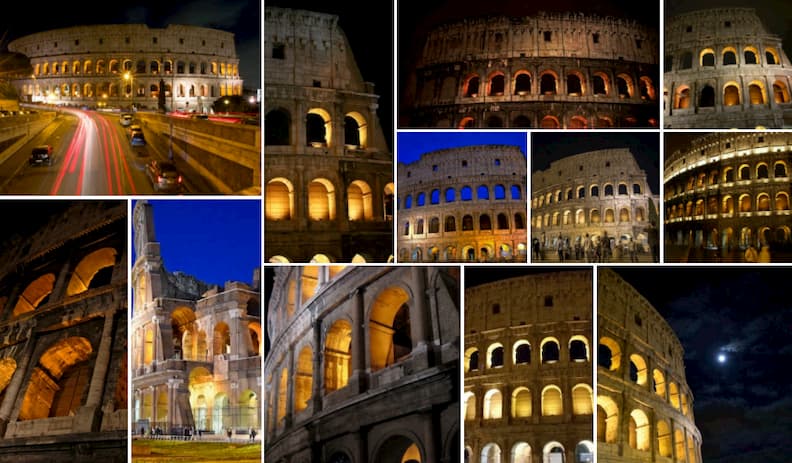
When we finally got “home”, we were tired, but not as much as I had expected. However, the hardest day was yet to come. Day 2 of our Rome holiday was supposed to be the most tiring (and it was!). It was also probably the best day of all our Rome holiday!
About the author

Mirela Letailleur is a Romanian travel blogger living in the South of France. She writes on The Travel Bunny travel blog about affordable travel in Europe, creator of unique free travel guides, local travel expert. Problem solver. Wannabe coffee guru.
Read more from our Rome holiday
Walking from Vatican City to Trastevere
Discovering Rome’s piazzas
More of Rome’s historical center

